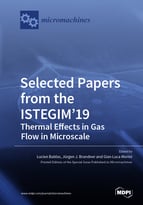Selected Papers from the ISTEGIM'19 – Thermal Effects in Gas flow in Microscale
A special issue of Micromachines (ISSN 2072-666X). This special issue belongs to the section "A:Physics".
Deadline for manuscript submissions: closed (29 February 2020) | Viewed by 36399
Special Issue Editors
Interests: micro scale heat and mass transfer; microfluidics; micromanufacturing; in-situ-measurement and micro sensors; miniaturized analytical systems; correlative measurement systems; nuclear magnetic resonance and imaging; metabolomics; scientific data management
Interests: microfluidics; gas microflows; fluidic microsystems; particle-laden microflows
Special Issues, Collections and Topics in MDPI journals
Interests: microfluidics; heat transfer in micro-devices; energy efficient buildings; heat pumps
Special Issues, Collections and Topics in MDPI journals
Special Issue Information
Dear Colleagues,
This Special Issue will publish selected papers from the International Symposium on Thermal Effects in Gas flow in Microscale ISTEGIM 2019 - A MIGRATE Event (http://www.istegim.eu/), 24-25 October 2019, Ettlingen, Germany.
MIGRATE (www.migrate2015.eu) is a H2020 Marie Skłodowska-Curie European Training Network, intended to address some of the current challenges to innovation that faces European industry with regard to heat and mass transfer in gas-based micro-scale processes. This network of 10 participants and 6 associated partners coming from all over the European Community covers different aspects of enhanced heat transfer and thermal effects in gases: from modelling of heat transfer processes and devices, development and characterization of sensors and measurement systems for heat transfer in gas flows as well as thermally driven micro gas separators, to micro-scale devices for enhanced and efficient heat recovery in environmental, transport, telecommunications and energy generation. The MIGRATE Project presents his 2-day symposium, ISTEGIM19, during which the members of the MIGRATE network will showcase the main achievements of the project. The program will include keynote lectures, invited lectures and contributed papers.
The symposium topics include, but are not limited to:
- Multiphase Heat Transfer in Microstructures
- Gas-liquid contacting
- Modelling and simulation of flows and heat transfer in microstructures
- Gas Surface Interaction
- Gas Sensors and Sensor integration
- Non-invasive measurement techniques
- Lab-on-device systems
- Microsystems for bio- and environmental applications
- Thermally driven microflows
- Heat recovery and energy harvesting microsystems
- Flow and heat transfer through micro-nano porous media
Prof. Jürgen Brandner
Dr. Lucien Baldas
Prof. Gian Luca Morini
Guest Editors
Manuscript Submission Information
Manuscripts should be submitted online at www.mdpi.com by registering and logging in to this website. Once you are registered, click here to go to the submission form. Manuscripts can be submitted until the deadline. All submissions that pass pre-check are peer-reviewed. Accepted papers will be published continuously in the journal (as soon as accepted) and will be listed together on the special issue website. Research articles, review articles as well as short communications are invited. For planned papers, a title and short abstract (about 100 words) can be sent to the Editorial Office for announcement on this website.
Submitted manuscripts should not have been published previously, nor be under consideration for publication elsewhere (except conference proceedings papers). All manuscripts are thoroughly refereed through a single-blind peer-review process. A guide for authors and other relevant information for submission of manuscripts is available on the Instructions for Authors page. Micromachines is an international peer-reviewed open access monthly journal published by MDPI.
Please visit the Instructions for Authors page before submitting a manuscript. The Article Processing Charge (APC) for publication in this open access journal is 2600 CHF (Swiss Francs). Submitted papers should be well formatted and use good English. Authors may use MDPI's English editing service prior to publication or during author revisions.









